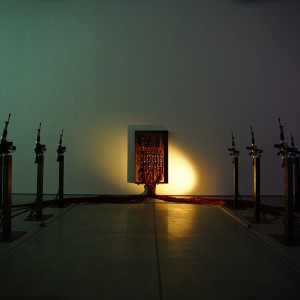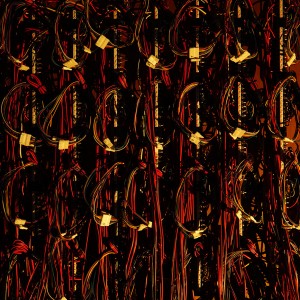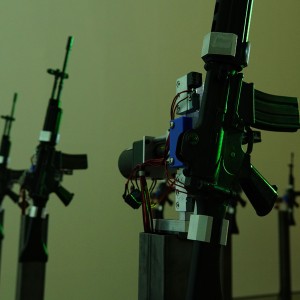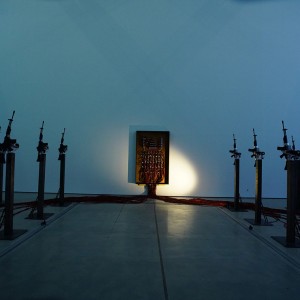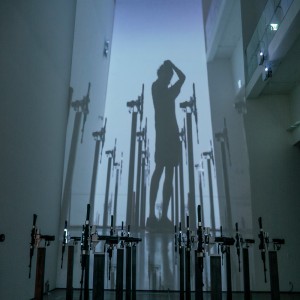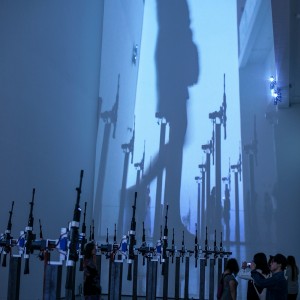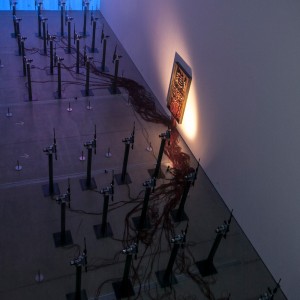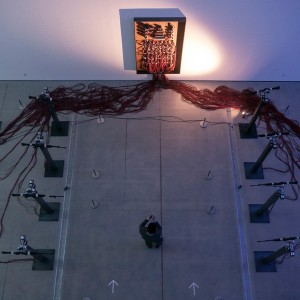Kelvin Kyungkun Park
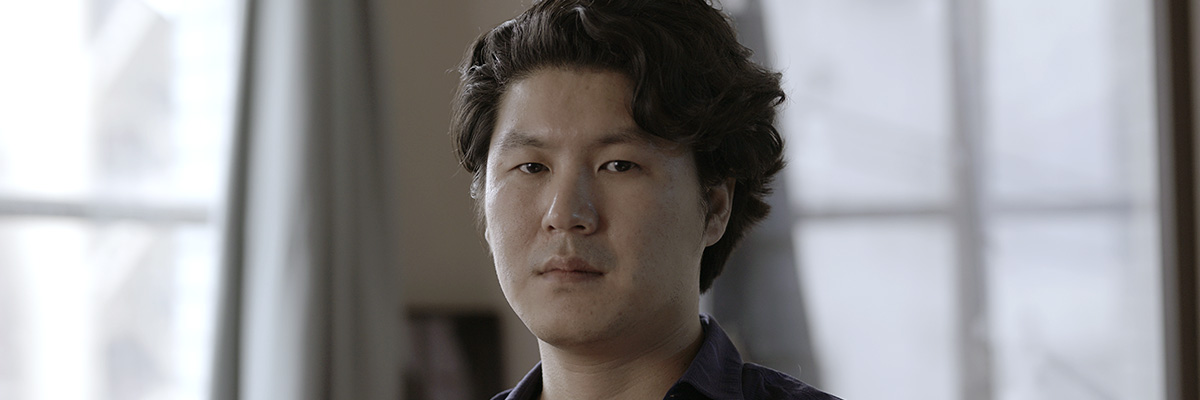
This exhibition asks powerful questions about the people who become a collective and are alienated within a system. As he recalls his experience of having been subordinate to the needs of the unique condition of the Army, and to the slogan of modernization, Park explores in an in-depth way the “site” where the archetype of today’s Korean men has grown. At the 14-meter-high exhibition venue, robots move uniformly with light and colors responding to the vibrantly moving sculptures.
Interview
CV
<Solo Exhibitions>
2015 Space Time Machine, Euljiro, Seoul, Korea
2013 A Dream of Iron, Opsis Art, Seoul, Korea
<Selected Group Exhibitions>
2017 Korea Artist Prize 2017, National Museum of Modern and Contemporary Art, Seoul, Korea
2017 Our Bright Future–Cybernetic Fantasy, Nam June Paik Art Center, Yongin, Korea
2017 Intuitive Landscape, Arario Gallery, Seoul, Korea
2016 Stopping by Woods on a Snowy Evening, Gallery Hyundai, Seoul, Korea
2016 ARTSPECTRUM, Leeum, Samsung Museum of Art, Seoul, Korea
2015 Commemorative Exhibition of the 70th Anniversary of Liberation: the Great Journey with the Citizens Uproarious, Heated, Inundated, National Museum of Modern and Contemporary Art , Seoul, Korea
2014 Korea, FiveMyles, Brooklyn, N.Y., U.S.A.
2012 Taipei Biennial, Taiwan
2009 Lil Joe’s, 9/11, Porn, Yanks and Murder, IMT Gallery, London, U.K.
2007 Düsseldorf Contemporary, Düsseldorf, Germany
2003 How Latitudes Becomes Forms: Art in a Global Age, Walker Art Center,
Minneapolis, U.S.A.
<Selected Screenings>
2015 Sharjah Biennial, United Arab Emirates
2014 Berlin International Film Festival, Forum Selection, Germany
2014 Museum of Modern Art (MoMA) Documentary Fortnight, U.S.A.
2011 Los Angeles Film Festival, U.S.A.
<Collection>
Arario Museum, Korea
Leeum, Samsung Museum of Art, Korea
National Museum of Modern and Contemporary Art, Korea
<Awards>
2016 Leeum, Samsung Museum of Art, Artspectrum Award, Korea
2015 Sindo Artist Support Program, Korea
2015 Wild Flower Film Award, Korea
2014 Berlin International Film Festival, NETPAC Award, Germany
2014 Rome Asian Film Festival, Best Documentary, Italy
2014 Taiwan International Documentary Festival, POV Award, Taiwan
<Residency>
2012 Seoul Museum of Art, Nanji Residency, Seoul, Korea
<Filmography>
2013 A Dream of Iron, 98 min, HD
2010 Cheonggyecheon Medley, 79 min, DV
Critic 1
Ki Heykyung (Chief curator and Managing Director, SeMA Buk Seoul Museum of Art)
Utilizing video as his primary media, Kelvin Kyungkun Park has perceptively traced the entanglements between Korea’s industrialization process and various elements and ideas related to pre-modernity and modernity. In Cheonggyecheon Medley (2010), Park explored the small metal-working shops and factories clustered around Cheonggyecheon Stream in Seoul, as well as the people there. In A Dream of Iron (2014), he used iron as his context for two of the dominant symbols of Korea’s industrialization: Posco (a steel-making company) and Hyundai Heavy Industries. Initially inspired by ancient drawings of whales from the Bangudae Petroglyphs, which he thought resembled modern-day ships, Park investigated these two massive industrial infrastructures, both of which are located near the Bangudae Petroglyphs. In addition to exploring his personal emotions, the film also contemplates the origins of Korean art and myth, and considers the role of cultural ideology in guiding the country’s contemporary history. More recently, in 1.6 Sec (2016), Park captured the incessant large-scale production of an enormous car factory through a dynamic play of light and air, heightened by the ubiquitous sound of robots. Army: Portraits of 600,000 (2016) examines how Korean society has been affected by the army culture experienced by most Korean men, who are subject to mandatory military service. Notably, in all of these video works, Park represents the male-centric hegemony of Korean society with a distinct symbol: iron, cars, and the army. Park uses these elements to unveil the masculinity embedded in Korean culture, and to reveal the hidden side of his visual spectacle, in which such culture unfolds.
Park’s most recent work again conveys an incisive critique of society but also demonstrates the evolution of his critical approach. It is a video and performance work entitled Stairway to Heaven, which most Koreans know as the title of a hugely popular TV drama from 2003, rather than as the title of the Led Zeppelin song. This work involved both pre-produced video and real-time filming of a performance at the opening of an exhibition, using the entire gallery as a backdrop. Like the drama, Park’s piece involves four major characters, and he uses performance to explore and classify the ways in which people form relationships with one another. Emotions experienced during the process (e.g., passivity and excitement, hesitancy and eagerness, joy and regret) are expressed through the faces and gestures of four dancers as they meet, slide by, and depart from one another. Most memorably, a real-time video of the live performance was juxtaposed with a previously filmed video that was projected on the walls of the gallery, thereby disrupting the audience’s perception of both time and space. Furthermore, two different videos were projected onto the walls: one video that had been previously shot, and one video that captured the “real-time” events happening in the gallery (including the projected video). Notably, Park used the exact same camera angle and set-up for both videos, thus creating a mirroring effect that made it impossible for the audience to perceive the subtle time gap between the two projected videos. The resulting work combines synchronization and asynchronization in the same space, so that the moment that has just happened, the moment that is now happening, and the moment that is about to happen are merged in the same video frame. By visually emphasizing the synchronization, Park actually evinces the asynchronous and segmented time that usually cannot be perceived with the naked eye. In his video, time is segmented, repeated, and mixed; continuity continually gives way to segmentation, and vice versa, as if a digital clock has been hung in the performance space. Park’s visualization of the spatial and temporal gap enables Einstein’s synchronization and asynchronization to coexist on the same screen. Such segmentation might also represent the dislocated and disintegrating relationship among the performers in the video.
Being set in a digitized time and space, this segmented relationship hovers around the past, present, and future, eventually eliminating the division between here and there, and between that moment and this moment. The critical approach of Stairway to Heaven echoes another of his earlier works, entitled Spatio-temporal Machine (2015). Both of these works demonstrate how Park, who started out as a documentary filmmaker, has begun to integrate elements of film and art, producing his unique works in parallel with these two fields.
Critic 2
Inside and Outside the Frame: An Interview with Artist Kelvin Kyung Kun Park
August 14, 2017
Mun Hyejin (Art Critic)
Mun Hyejin (Mun): In this interview I would like to focus on your new work Mirror Organs: A Play of Metonomy that will be shown in Korea Artist Prize 2017, and on some of your previous works that are related to them. Let us first talk about the new work. Though you must still have a lot of final decisions to make, my understanding is that the major structure is set up.
Kelvin Kyungkun Park (Park): My new work is the embodiment of a semi-autonomously activated closed-circuit feedback loop. The entire exhibition space is a gigantic movie theater or stage surrounded by two screens facing one another. Model guns are lined up between the screens. At a certain moment, the guns, which are modeled after the K2 rifle, move like soldiers in an inspection of the honor guard. (The exact cycle and method of movement are yet to be decided.) Between the screen and the model guns are installed two cameras facing each other. Each camera films the scene in front of it (the screen it faces and the movement of the lined-up guns) and sends the footage real time to the screen. Viewers may walk between the two screens or stand in the middle to face the gaze of the screen.
Mun: I feel that the semi-automatic nature of the work, which is neither completely programmed nor completely random, is interesting and important. Could you elaborate some more about the conversion structure of the video?
Park: The video consists of the generated image (G), which is produced and projected, and the mirrored image (M), which is the image of the installation taken and transmitted live. Since there are two screens, there are four possible combinations: (G, G), (G, M), (M, G) and (M, M). G is composed only with changes of color and tone without any particular images. It can be divided into images of low intensity (G1), and images of high intensity (G2). The reason I omitted concrete images was to embody light itself. In the case of M also, there are four different options: black and white, RGB color, YCbCr color, which simplifies the color information, and special effects. Though the transitions from one image to another are irregular, the programming maintains an overall balance among the proportions of the images. The trigger for the transition of G1, G2 and M is sound that exceeds a certain level of decibels. Usually this is the sound of the guns moving, but it can be changed through the intervention of spectators—such as by making loud noises.
G1 (low) |
G2 (high) |
M(CAM) |
Combination1 |
Combination2 |
Combination3 |
Combination4 |
|
CH 1 |
3/7 |
2/7 |
2/7 |
G |
G |
M |
M |
CH 2 |
3/7 |
2/7 |
2/7 |
G |
M |
G |
M |
B&W |
RGB |
YCbCr |
Effect 1 |
|
M (CAM) |
1/4 |
1/4 |
1/4 |
1/4 |
Mun: The core elements of your new work seem to be related to an exploration of the basic structure of video (film), i.e. light, camera, projector, screen and spectators. The projector in this case is not only a device that passively projects generated video, but also acts as a light source for the camera on the opposite side. The screen also is a passive surface on which the projected video is played on one hand, but is the stage of a show taking place before it on the other hand. While movies have a unidirectional structure, as the light from the projector hits the screen and the spectators also face the same direction, you created a two-way closed system by overlapping this structure. This is what gives the work conceptual and structural tension. I think your omission of concrete images from the generated image (G) was also an appropriate choice. For the video to simultaneously function as light, contents (images) would be interference. Showing the texture of light itself is more effective. In that sense, I think the noise of the pixels breaking up and the flickering effect well embody the nature of light in the digital era.
There are many examples of infinitely reflected live video closed-circuit systems, such as Dan Graham’s Present Continuous Past(s) (1974). But while many previous precedents created closed systems of infinite reflection by using mirrors, your recent work uses two cameras facing one another to create a reflexive closed circuit. In this case we can perceive that there is a different focus. For instance, the cases using mirrors are most likely emphasizing the aspect of time. While the mirror represents the present, the recorded video represents the past, because even if it is taken real-time, there is bound to be a time difference. Therefore, the infinitely reflected video images are like strata of time—endless layers of pasts from a few seconds earlier, interlocked with the present. Meanwhile, in the case of your new work, the emphasis seems to be on the gaze, not the time. The two cameras facing one another are a mutual gaze, and the viewer’s experience of facing the screen on which his/her image is being projected, also reveals a strong aspect of mutual staring.
Park: Correct. A core part of the effects I intended for the new work is related to the gaze. There are two projections and two cameras, and the spectators go between them. Here, the spectators are penetrated by the two-way gaze taking place. Perhaps this is a feeling similar to that of going into the middle of a densely woven two-way laser mesh. The emotion I felt as I devised and tested this structure was fear. I felt like I was being inserted into a surveillance circuit and my body was being severed. The tension occurring between the two-way gaze, and the fear of the body being pierced there, is the foundation of my work. Meanwhile, the sense of fear is also caused in a somewhat different direction—the fact that the live video does not continue. If the picture suddenly changes after the live video has been showing me, it feels as if I have suddenly disappeared. It’s something like the feeling of my existence being erased. First I am in a stable structure, and then suddenly the space changes regardless of my will. At this point, there is a sense of disorientation, not knowing where this is.
Mun: As for the last part, I cannot make an exact judgment, since I have not experienced it yet. I understand the transition of the picture gives the feeling of sudden severance, but the feeling of fear would be different depending on the person. In the sense that the mirror image, which lets me perceive that the camera is looking at me, shows me and the space I belong to, it could be an image of a stable world; however, to someone like myself who does not like to be the object of a gaze, the reflection may be uncomfortable. In this case, the transition of the screen image and the disappearance of my image may not be fear, but relief.
Park: Perhaps. Anyway, for me the sense of disorientation was important. Another thing I intended in terms of the gaze was to give an uncanny feeling when a screen was projected on another screen, as if the screen was looking at me. If the camera positioned behind me takes my rear image and projects it on the screen behind me, my rear appearance, which I am unable to perceive, will appear behind me. To perceive this is quite frightening—the chill you feel when you realize that someone has been watching you without your knowing.
Mun: That I can easily agree. It reminds me of Lacan’s allegory of the “sardine can.” The fear of an object/other gazing at me is universal. But what intrigues me here is not the fear, which is the consequent effect, but the structure that induces it. In this case, the introduction of interactivity to the traditional one-way screening structure, the unpredictable and irregular transition of scenes, rather than presentation of a complete video, intervention of spectators in the feed-back loop, and kinetic robots acting as triggers for the transitions of the video are all characteristics that make your work different from the classical film structure. To me, your work seems traditionally filmic on one hand, but also seems post-filmic on the other. Of course the concept of the filmic here does not refer to the aspect of contents, such as narrative, but to the structural aspect. It is interesting that you are based in extremely traditional devices (camera, screen, projector, light) and concepts (the gaze, for example) of filmmaking, but twist them. This characteristic can be seen not only in this piece, but throughout your body of work. You have a solid ground on film, and the formal aspects have always been important in your entire works.
Park: I agree. In a way you could call me a formalist (laughs.) In fact, I did receive thorough training in filmmaking, and I am accustomed to looking at objects through the camera frame. While the formal aspects are always important, I don’t tend to make conceptual approaches when I plan my work. My senses react before the concepts. For example, in the case of A Dream of Iron (2014), my guideline for editing was sense rather than concept. I stress the rhythm according to the difference of texture, for instance, something calm comes at first, and then something hot comes. In the multi-channel version of A Dream of Iron, the major axis of editing was the transition from the vertical to the horizontal. First the image, and then the concept follows. The images that are hanging or standing vertically, later lie down. I start with vertical images such as whales standing up straight, a ship hung up to dry upside-down, and a pillar of fire, and finish with iron plates neatly stacked horizontally. This can be interpreted as the end of symbols visualized by verticality (industrialization, masculinity, iron, dictatorship, etc.). But I am not mobilizing images in order to explain grand narratives. It is more appropriate to say that the images and sounds correspond to my intended emotions or senses, which then can be interpreted by the audience as concepts or symbols.
Mun: Considering that senses or emotions lead directly to the composition of image or sound, it could be said that your form leads your contents. But let us now return to Mirror Organs. At first glance your works seem to be separate, without many commonalities, but if we look closely, there are many instances where elements from previous works are used in variation in your subsequent works. Even in your new work, a dark shadow of your former work seems to be cast upon it. For example, the kinetic object, which first appeared in Space Time Machine (2015), is fully implemented in Mirror Organs. To my knowledge, the idea of live video was also first attempted in Space Time Machine. Conceptually, what is directly connected to the new work is this aspect of live video, rather than kinetic factors. So what did you gain from Space Time Machine, and how was this connected to your later works?
Park: Space Time Machine was a work in which I experimented with the tension between video and actual objects. The work features two different types of machines that make space and time. One is an object that actually moves as it creates a sense of time and space, while the other is a video that creates virtual time-space. The movement of the object is filmed live by a camera and projected back onto the object, which acts as a kind of reflector, thus interfering with the video image. (In result, the projected image and the movement of the object correspond with one another in real time, changing endlessly.) What I confirmed in this work was that the video appeared much more realistic than the actual object. The movement of the installed object was too slow, and therefore hard to determine whether it was actually in motion; but in the video the movement can be seen much more clearly. Though this can be interpreted as the ontological difference between the illusion and the reality, what was more interesting for me was the tension, which could be sensed when seeing the real thing and the image at the same time.
Mun: I suppose the work in which that point was specifically expanded was last year’s live performance video, Stairway to Heaven (2016). That was the first time you applied the concept of mirror reflection in your work, and Mirror Organs also looks like a modified live performance, in which you have replaced the actors of Stairway to Heaven with robots (guns). The formal core of Stairway to Heaven was the gap between the real (performance) and the image (live video of the performance). Please explain this structure.
Park: In Stairway to Heaven I wanted to show the tension between what the camera showed and what could be seen with the naked eye. With our eyes, we usually see the background as well, and the whole body of the performer. On the other hand, with the camera—especially in close-ups—I can exaggerate a particular facial expression or a certain part of the body. The actual movement is exaggerated or diminished as it is transmitted to the screen, and a certain tension is formed in this dislocation. For example, it is difficult to see the detailed expressions of the actor with our eyes alone, but with the camera we can capture the delicate emotions revealed by movements of the eyebrows or mouth. But my intention here was not to use video as a complementary measure for the eyes. Rather, I wanted to show the tension that occurs when two different states coexist in a singular vision. In this work, spectators simultaneously look at the video inside the frame and movement of the actor outside the frame. That is because the performers before their eyes move continuously, and the live images projected on the screen deceptively correspond to reality. While jumping in and out the cycle of absorption and detachment, I wanted to create a state of not being able to empathize completely with either side, or the emotion of feeling both states at once. I once felt the same feeling I had previously while driving alongside the Pacific Ocean in California, when actually I was driving along a highway on the west coast of Korea, looking at the sunset above the horizon. It was not a recollection of a memory, but a strange experience, as if I was feeling the state I had felt before, simultaneously here and now. I wanted to somehow express this state of being synchronous.
Mun: Since your performance only took place at the opening, and after that there was only the video, it is hard for me to determine if that gap was actually well-embodied, as I could not make it to the opening. But presumably, the double structure you intended would not have been successfully communicated. There are two main reasons for this: one is that because there is a narrative, the majority of spectators would have focused on connecting the scenes in order to understand the story. Particularly since the story was based on a famous TV drama, and the emotional line was powerful and sensational, viewers would have had to pay close attention to understanding the relations among the characters and following the fluctuations of emotions. Another factor is the music. It is my understanding that you used Spanish guitar music to help the performers’ emotional acting; however, because the music is so sentimental, viewers would have been immersed in the emotional acting of the performers, rather than seeing the structure inside and outside the frame.
Park: I agree in the larger context. In the case of the music, I removed quite a bit of it during re-editing because I thought it was too much. As for the story, it is indispensable in terms of my work intention. I thought the behavior of the drama’s main characters, who betrayed their own emotions and were swayed by their surrounding situations, reflected Koreans in general including myself. I thought the desire mechanism of myself, from which subjectivity was excluded, reflected a characteristic of Korean society, and I intended to reflect this through the narrative structure of the drama.
Mun: How does the intention concerning the contents you just described connect with the formal composition of repeating absorption and detachment?
Park: The protagonists of Korean TV dramas appear to react according to external situations, rather than acting according to their own feelings. Behavior is often decided according to situations given from the outside, such as human relations, economic or social backgrounds. Emotions also seem to be formed under the influence of external factors. The self is already relational. The emotional basis for making decisions don’t occur through an internal mechanism, but are injected from the outside. If they were “personal” emotions, the characters would be able to be immersed in one another completely based on their own decisions and subjectivity. This does not happen, as we are always looking to see what others think. But since this does not mean there is absolutely no subjectivity, they remain in an ambiguous state, unable to keep distance nor be completely immersed. I wanted to express this strange dual emotional state, in which the characters go back and forth from being immersed and not being immersed, which was embodied through multiple viewpoints that divide inside and outside the frame.
Mun: The intermediate nature of shuttling between inside and outside the frame seems to be something that appears in all your works, not just Stairway to Heaven. After all, you are also on the border, not belonging to either Korea or the United States. Even works like A Dream of Iron and Cheonggyecheon Medley (2010), which seem to have little relation to Stairway to Heaven, have some similar points, including the attitude of the camera approaching the subjects. In these cases, the camera does not completely empathize with the subjects, nor does it assume the perspective of a complete outsider. It maintains a dualist state with one foot in and one foot out. It is the same with Army (2016). I once asked my students about this work in class and got the most diverse responses, from a comment that the viewer was offended because it felt like a foreigner observing Korea, to a response that perhaps the artist was empathizing too much with the subject matter because he had joined the military service too late, along with many other comments depending on the students’ gender or whether or not they had served in the military. Such dispersed reactions have something to do with the specificity of the subject matter of military service, but I believe it also can be attributed to the fact that the angle of the camera was half attached and half separated.
Park: I believe the term “intermediate” can be confusing. I don’t think an intermediate attitude is good in life. Jumping in completely, and jumping out is my basic attitude. For me my work is part of the exploration of my subjectivity. As an East Asian carrying the burden of historical mutation, in order to know who I am, what I want, I must come out from the frame (national, cultural class or gender) I belong to. I must jump outside the frame to see what frames me and jump right back in repeatedly. Meanwhile, in order to sustain subjectivity, I must be completely involved, while acknowledging my limits and be thoroughly aware of on my own desires because East Asian societies favor collectivity, systematically repressing the individual voice. Only then can I gain a perspective, a subjectivity and gain some persuasive power in my voice. In short, I must attempt to see only what I want, and nothing else. That is why I believe my two feet must be inside the frame, and my head must be outside the frame. I think this is the way I can live life seriously, while making a joke of myself. Taking responsibility is important, but if I become so serious and so important that I cannot mock myself, I will then be an irritating asshole.
Mun: Let’s now move on to the work 1.6 SEC (2016). In that it comments on the essential structure of video, including camera, viewers, space and screen, 1.6 SEC is the work that is directly connected to your new work Mirror Organs. The overwhelming impression/keyword in this work is the machine vision. Channel 1 shows the movement of a machine assembling a car, while channel 2 shows the movement of the camera filming the machine. Here the movement of the camera imitates exactly the movement of the machine on the assembly line, and since the camera is also a machine, both channels represent the viewpoints of machines. The key element that provides the heterogeneity of the machine vision, not human vision, is the camera work. The movement of the camera, causing the screen plane to turn upside-down, swirl and rotate, as in some scenes of Channel 2 of the machine watching the painting on the wall, presents an unfamiliarity. How did you specifically set up the camera work?
Park: The movement of the camera is an exact imitation of the movement of a machine on the assembly line. Originally I wanted to attach a camera to the robot arm on the assembly line, but because of safety issues this was not possible, and I had to film the motion separately. I borrowed motion control gear, attached the camera and moved it by remote control. Since one had to film the robot arm and one had to film the camera filming it, I mounted two cameras on the motion control gear. Assuming that channel 1 was the viewpoint of the machine, and channel 2 was the viewpoint of the camera, I edited the footage so that channel 1 would gradually become distant, and channel 2 would gradually become closer. In realizing the rotating camera work, I used the Dutch roll technique, which is an effect of taking away gravity by rotating the Z axis based on the picture. I also used Jimmy Jib shots to ascend along axis Y, and tracking shots to move horizontally. By using a lot of techniques to move the camera itself, I tried to visualize the vision of the moving robot.
Mun: In this work the camera movement seems dazzling at first, but is in fact simpler than one may think. It consists mostly of rotation movement. To give the machine’s view a sense of difference, you could have further emphasized the discontinuity through speed, zoom, the sense of cutting off in editing, etc. Was there a reason for simplifying the camera technique?
Park: I thought the method of using fancy camera work had already been used a lot in commercial films, and had therefore become cliché. Though the video image appears to flow along plainly without fluctuation in dynamics, this is actually a trick. In some cases I normalize the speed by making fast-moving objects look like they were moving slowly and vice versa. For example, the movement of the robot arm in the beginning of the video, which appears to be moving slowly, was filmed at a high speed of 120 frames per second, and projected at normal speed to make it look slow. I manipulated it to appear slow because I wanted to give the feeling of it going into motion gradually, as if a person stretches his arms right after waking up. There are some parts besides this where I made the motion seem slow, such as the part with the clock and the part with a person appearing. In the case of the clock scene, I manipulated it to play in reverse. Showing human beings, I altered the speed because I imagined that from the machine’s point of view, the movement of human beings would appear slow and delayed.
Mun: Showing the clock in slow motion seemed like you were emphasizing the flow of time. The concept of time seems very important in this work. Let us talk some more about the difference between actual speed and the apparent speed you just explained.
Park: I wanted to make a structure that looked like it was moving at a steady rhythm, but actually had mechanisms of different rhythms: accelerating or decelerating in a whirling motion embodied in a flat, linear velocity. Since people need a commonly agreed time in order to carry out social life, they inevitably go along with the mechanical time. But people are biological beings, and therefore have their own biological times. When there is discord between these two kinds of time, conflict and various emotions occur. For example, if you have a deadline but your physical condition can’t manage to follow it, you feel anxiety or frustration.
Mun: The idea of non-linear and heterogeneous temporality is important. The structure of time you just explained would be easier to understand if we picture the concept of longitudinal waves—like when you push a spring back and forth, the force of the push is transmitted in different densities through the spring. Though the energy is transmitted as the dense and the loose parts appear in alternation, because the direction of the waves and the direction of vibration in the medium are parallel, there seems to be no movement on the surface. Such an image could appropriately illustrate the structure where times that appear to have constant speed, but in fact have different rhythms, coexist. Meanwhile, the concepts of mechanical time and biological time seem to require additional explanation. Let us talk some more about your intentions in planning your work, and the relationship between time and emotion.
Park: This work was produced as part of the “Brilliant Memories” project hosted by Hyundai Motors. The Hyundai Motors assembly plant has already been automated and is operated based on machines rather than on humans. While looking at the machines, which can be seen as the actual subjects of the factory, I thought about humans’ time and robots’ time. Because sensations are felt through time, and human time and robot time are different, the sensibilities of robots would be completely different from those of humans. Human emotions begin from sensory perception, and since sensation requires time, emotions are inseparable from time. That is to say, time is the form of emotion.
Mun: Though people with different biorhythms must match themselves with mechanical time in order to live in society, under the surface we can find the coexistence of different rhythms unique to the individual. The emotions humans feel are also time-dependent in principle, and occur in the gaps between mechanical time and biological time. This could be summarization of your intention. But I doubt whether it is fundamentally possible to divide humans’ time from robots’ time. I think the time of machines is already melted in the sense of human time, and though there may be some relative difference, it would be difficult to divide the two fundamentally. As you mentioned, our social time is based on mechanical time, and our bodies have already been tamed to the standardized and segmented nature of such time. Moreover, as technical civilization develops, we become more surrounded by machines, thus causing our senses to become increasingly more mechanized. This is easily understandable if we think about our lives before and after the use of smart phones and computers. While novelists of the past developed their thoughts through handwriting, the ideas of today’s novelists begin to flow only after they turn on their laptops. Since your senses and views as an artist have been tamed by the camera, it is only proper to say that your vision also includes a mixture of the machine’s vision and the human’s vision. I believe machines’ time has been implanted in humans’ time per se, which has already become so hybridized that the two cannot be separated.
Park: I certainly agree. What I wanted to express in 1.6 SEC was also the suspicion of the dichotomous division between humans and machines. While looking at the lively movements of the robot, I felt a strange sense of identification, and my contemplation on where this feeling came from became the starting point of the work. If we were to say the main factor in differentiating between humans and robots is emotions, which in fact are necessary in communicating with and relating to others, then, emotion is not a property unique to an individual, but a social composition. There was a conflict between the company and the labor union because the company wanted to accelerate robots by 1.6 seconds to improve production timeline. If the speed of production by robots in an automobile plant is accelerated by 1.6 seconds, this is not a problem for machines, but for workers. While machines can immediately adapt organically to the change in the production environment, workers who are already accustomed to the existing rhythm had difficulties adapting to this change. Perhaps that is why I thought that in the car plant the machines seemed more alive than the humans. But when I thought about the reason behind my bias, it was because my viewpoint was already in fact that of the camera, the machine.
Mun: The issue of robots and humans is repeated in your new work in the form of model guns. Let us return to this issue later, and go on to that of the video’s structure. As I watched the movement of the camera in 1.6 SEC, I personally recalled La Region Centrale (1971) by Michael Snow. In the case of La Region Centrale, the movement of the camera was not segmented but continuous, which allowed the spectators to follow the movement of the camera and become united with it. In other words, the spectators’ eyes were positioned exactly at the “empty center”(position of the camera), which is not shown in the video. Meanwhile, in the case of 1.6 SEC, the movement is continuously cut by editing, making it impossible for spectators to have a single, continuous, united perspective. Furthermore, since it is two channels that cannot be seen at a single glance, the discontinuity, or dizziness of disorientation, is further strengthened. Let us talk about the relationship between the viewers and the camera in 1.6 SEC.
Park: Since I was trying to embody the sense(vision) of the machine, and express this through a skin of mechanical time (but actually a complex time in which times of different strata are entangled), I naturally thought the cuts had to be made. In fact, I tried to visualize the cuts more vividly by reinforcing the editing. Since the machine itself is segmented, I tried to bring out the feeling of segmentation in the video as well.
Mun: As I mentioned earlier, in 1.6 SEC, the camera is equivalent to the machine in the assembly line. Since the view of the artist is equivalent to the view of the camera, the equation of Camera = Machine leads to Director = Camera = Machine. In the case of Snow’s La Region Centrale, the camera becomes the viewer because the camera is not shown. In 1.6 SEC, however, the camera is shown, and the viewer becomes an outsider. But an interesting point is that the spectator, who has become an outsider, again becomes an insider due to the installation of two channels. The spectator, surrounded by machines filling the screens, becomes a gadget locked in the machine in the assembly line. The entire installation (including sound and image) become a machine that ascends and descends regularly.
Park: Since I composed channel 1 as a scene filmed by a camera (movement of the machine), and channel 2 as the camera filming that, with channels 1 and 2 installed to face each other, the viewer will naturally be positioned between the two screens. Here the installation space becomes the interior of the camera. That is because the body of the camera exists between the camera lens and the scene. Therefore, the spectator finds him/herself inside the camera.
Mun: Though this may seem far-fetched, I wonder what it would feel like if this work were viewed in a 4DX theater. I am curious how the feeling of disorientation would change. Of course I know this is an absurd idea.
Park: Since it was not taken with a miniature camera, sense of scale would be off.
Mun: You take my joke too seriously (laughs). Finally, I would like to talk about the non-sync, which in my opinion is the greatest charm of 1.6 SEC in terms of structure. The two channels of 1.6 SEC are of different lengths. Channel 1 is 16 minutes and 25 seconds, while channel 2 is 12 minutes and 20 seconds. Moreover, I understand that the sound was also produced separately. Because the videos of the two channels and the sound are all independent and different in duration, each combination of image 1—image 2—sound will be different every time. (In reality, no viewer can see the same video.) Is this composition, which is a kind of random combination, an attempt to escape from the classical film structure, in which the length and composition of the film are fixed?
Park: You could say so, but rather than being conscious of paragons, I wanted to make a different structure. Simply, I thought there was no need to match the sync because one would not be able to see the two channels facing one another at once anyway, and I thought it would be good if the combination continuously changed. It felt visually more effective to generate new combinations through the continuous incongruity. I wanted unexpected and unintended things to happen in the collisions between image and image, image and sound. Through this method I ultimately wanted to create a different structure, which was a pattern but also not a pattern.
Mun: The form of pattern that is not a pattern coincides with the compound time concept we discussed earlier—the compound structure in which mechanical time and organic (biological) time are interlocked. Formally and conceptually, you seem to like flexible structures. Haven’t the aspects of spontaneity and unpredictability increased in your latest work Mirror Organs? Since the transition of the pictures is activated by sound exceeding a certain level of decibels, spectators stomping or sudden actions can trigger transition of the scenes, in addition to the pre-planned sounds. What kind of image will appear in the next scene on the screen is also semi-automatic, as it is a matter of probability.
Park: With the exception of A Dream of Iron, in which the images of each channel must be symmetrical, I did not match the syncs in the other multi-channel works. In Cheonggyecheon Medley also, the lengths of all five channels are different. As the planets in the solar system each have different orbits and encounter one another at different times, the time difference given to each channel as it is repeated results in a different combination every time. Such combinations are not intentional, but may seem to spectators as if they were planned. What I consider important are the asymmetry and polyrhythms created by the combining of images. In my new work, I further strengthened the aspect of spontaneity in comparison to 1.6 SEC. While the order of scenes—which image would come after which—were decided in 1.6 SEC, in the new work, editing cuts are decided by the robots (and the sounds made as they move). The robot’s movements and the transition of scene caused by such movements, however, are also decided by a program. (The movements of the robot are wired with an analogue circuit, and the transition of scenes is assigned within the probability set by the program code.) Such non-intentional editing may seem random at first, but is in fact a reinforcement of my intention. That is because I have complete control over the chance proportions of picture transition. I do like unexpected discoveries, but I also hate disorder.
Mun: Let’s now come back to the issue of robots and humans. Your new work Mirror Organs applied and expanded the combination of drama and video, which you had experimented with in Stairway to Heaven. While this work is a gigantic cinematic feedback loop space on one hand, it can also be seen as a huge theatric stage using the video as lighting on the other. The actors in Stairway to Heaven were replaced with robots. The keyword “robot” has been used from time to time as subject matter or concept in your works, such as 1.6 SEC, but never did you embody robots physically on such a large scale. This seems to be your first time to materialize moving objects full scale. Were there any particular difficulties in realizing this?
Park: First of all, I didn’t have the budget to hire actors for the entire duration of the exhibition (laughs). I chose robots because I thought they were easier to control. I was completely wrong. Having to manage mechanical and structural design and to program the movements of the robots was a big problem. I suddenly had to install an engineer’s brain in my head. The difficulty was to give robots sharp, disciplined motions. The beginnings and ends of their movements had to be clean and graceful like those of well-trained honor guard, but it was not easy to embody this mechanically. Because of inertia occurring in the direction of movement, there would be recoil when they stopped. Such error is caused by a combination of numerous variables, including budget, equipment, velocity and inertia. I had to create the movement I wanted with the equipment possible within a limited budget. I solved the recoil problem by adjusting the speed of the robots and using the friction of plastic parts. Meanwhile, I also had to consider possible malfunctions during the long exhibition period. For such reasons, I chose an analog system, rather than digital. In the event of malfunction, a digital system would stop completely, while in an analog system only one robot would stop functioning.
Mun: In Mirror Organs, the robots (model guns) placed between the video screens evoke the young men (humans) featured in Army. Here the robot actually visualizes the gaze of the machine (camera)—as the aimed gun symbolizes the gaze of the camera, which is looking in the same direction, the spectators standing between guns pointed at them from both sides can feel the presence of the two-way gaze with their bodies—but on the other hand, it also serves as an analogy for the condition of the individual, who lives as part of a group. In that sense, Mirror Organs can be linked conceptually to Army.
Park: That is exactly what the military does to an individual. It makes robots, and turns individuals with different characteristics into parts of a collective. I sometimes feel that I am like a malfunctioning robot. Robots work only according to what has been fed to them, unable to think on their own. We are like malfunctioning robots, which don’t work when they are required but work only when they are not needed. The movements of the robots were designed in emulation of honor guard ceremonies, or various kinds of training conducted in the military. The training is repeated until all constituents are completely synchronized. As they repeat only the salute motion for four to five hours, the individuals are reborn as parts of the group.
Mun: I understood your explanation to mean that the masculinity of Korean men is not biological but rather something composed socially within the male group, and there is collectivism behind that mechanism. To say that someone is not an individual but part of a group is to say that he is unable to act subjectively, and that his standards of determination are outside. (This question is also raised in Stairway to Heaven.) Moving on to the structure or mechanism of masculinity here would be deviating too much from the topic of discussion. After all, your new work Mirror Organs does not deal with masculinity as deeply as Army. But I do have to ask this question. As a Korean man, what is your position on the masculinity of Korea, which reduces the individual to one of the group? Is it fear, captivation, or both?
Park: Fear and captivation both exist. Being subjugated to a group and my disappearing, losing the ability to make my own judgments, becoming what I consider to be a problem…this is frightening. When I witnessed someone being stomped on in boot camp I pledged to myself that I would never be that kind of superior. But when I later became a squad leader, and one of the soldiers ignored my directions during training, I grabbed him by the collar, threw him down on the ground and stomped on him in an attempt to intimidate him. As I yelled at him, I felt this infinite fear. In a course of two years, I had become the same kind of person without even realizing it. In retrospect, the reason for such fear may be a desire to become someone better than “them,” more “noble” than them. Meanwhile, the attraction can be interpreted as a kind of sense of belonging, which is in fact extremely effective. There is also the aesthetic pleasantness.
Mun: I understand the effectiveness, but what is the aesthetic pleasantness? Are you referring to the pleasure when one witnesses the complete synchronization in a mass game? Isn’t that a pleasure of someone looking at it from the outside, rather than the performer himself?
Park: Of course. The attraction I speak of is not the urge to become part of it but the desire to create a frame and observe it. Perhaps this is my identity as an artist. Because I am not free to escape from it at my own will, I imagine making a frame and getting away from it, while I observe from the outside.
Mun: You seem to be talking about the attitude you mentioned earlier—neither being completely immersed, nor completely being a bystander (or either being completely immersed or completely ignoring). Perhaps the creation of such an ambivalent state is the central motive penetrating your entire body of work. Finally, I want to conclude our talk with a discussion about materiality. Though you started out with filmmaking, the proportion of installation seems to be gradually increasing in your work. Is it that you felt a limitation in the non-materiality of video? Why is physical property important to you?
Park: In short, I think the senses felt by the body are important. Video images can show tactility, which is of greater importance in better images. But digital video is an indirect sense mediated visually, and it lacks direct physicality. Video images can be rewound and played indefinitely, but with real objects, which are restrained by gravity and materiality, and manifest a one-off, finite nature, there is no turning back.

